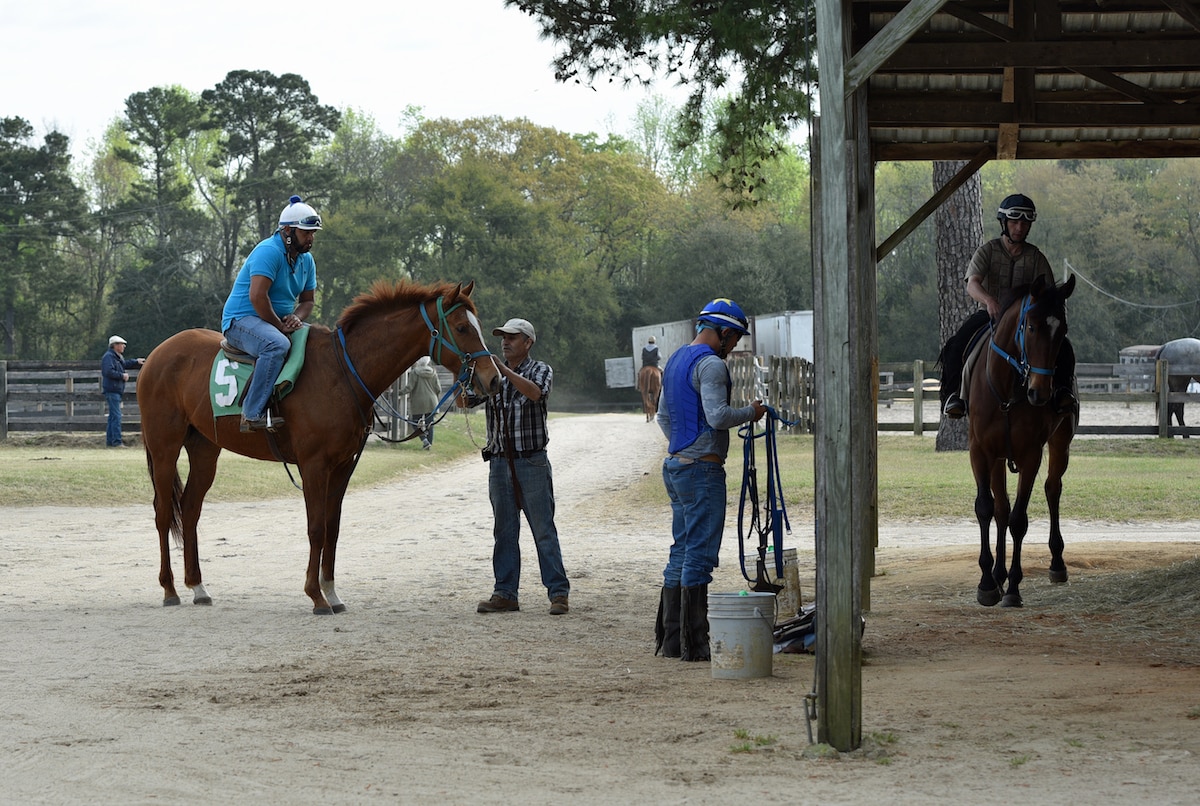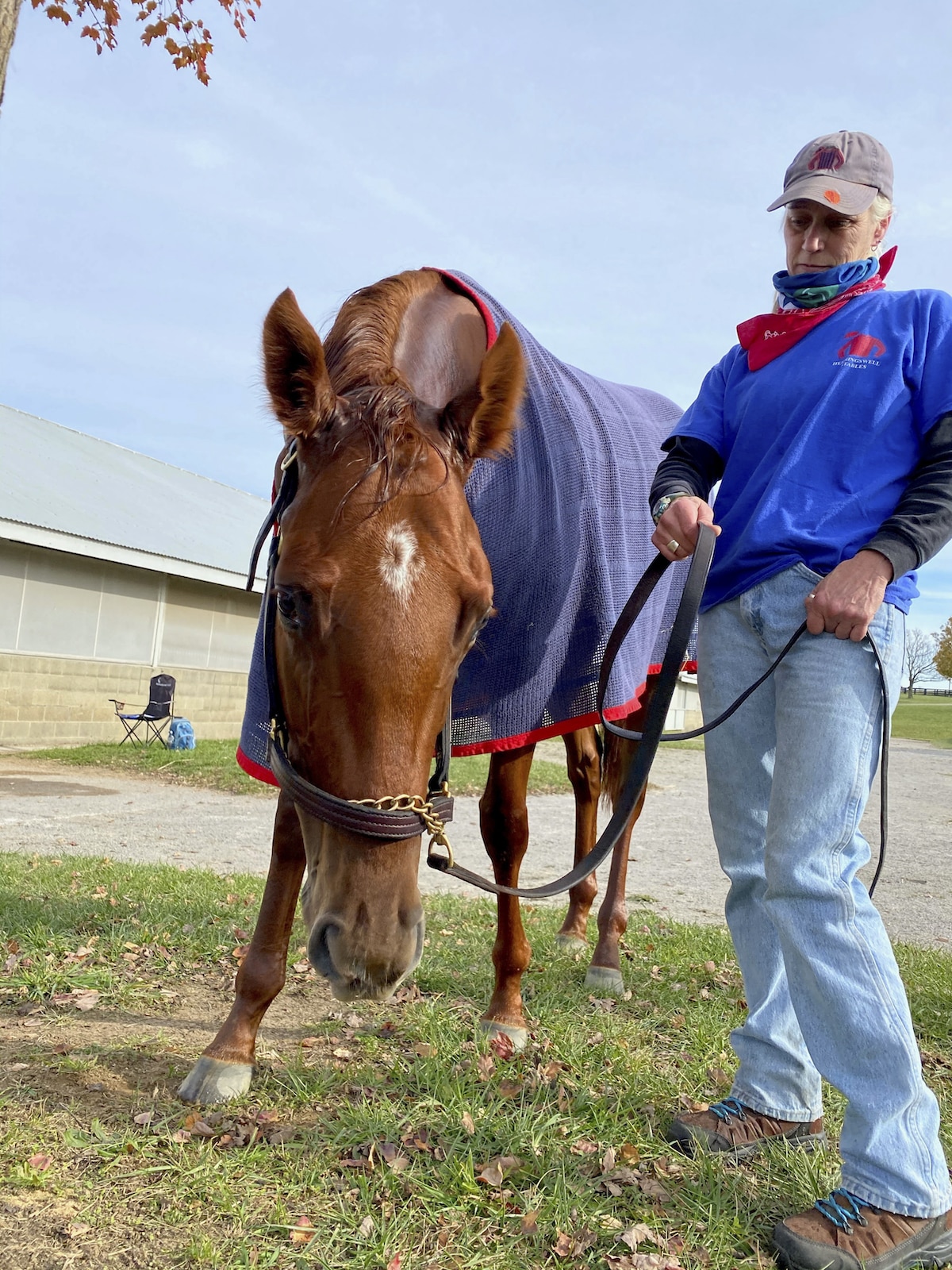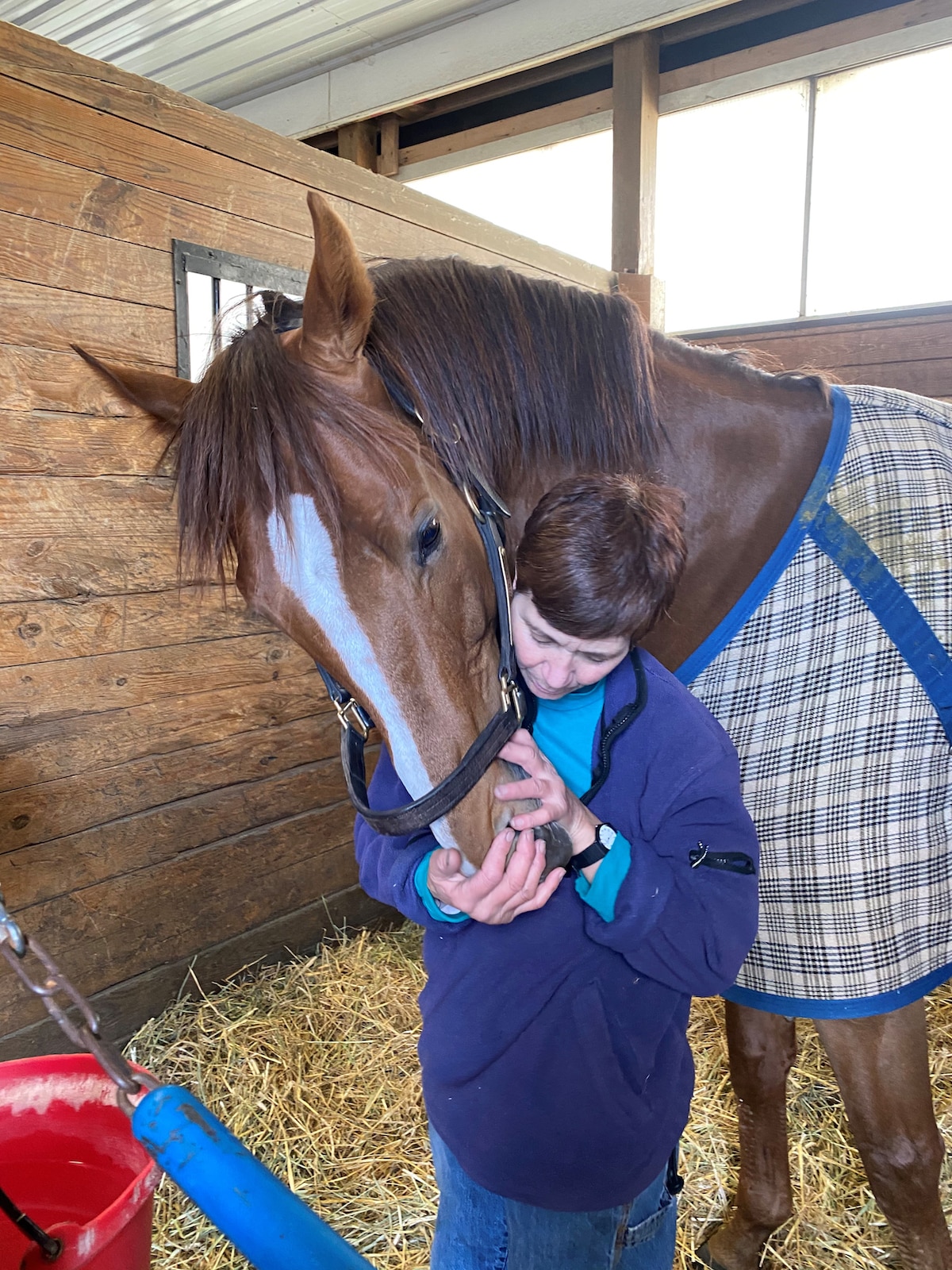Racehorses, just like riding and show horses, get groomed to the nines

Racehorses get groomed immaculately before and after morning exercise or racing. Courtesy Maggie Kimmett
Lisa Conway and Mickey Hall perform many of the same grooming tasks you do with your retired racehorse. But they start at 3:30 or 4 a.m. every day and work with four or five horses each in their jobs as grooms for racehorse trainer Graham Motion. While they don’t own the horses, they love them just as passionately.
“We take care of them all the same,” says Hall. “Some of them have the best personalities, and you love all your babies. Our goal is they can all be productive at whatever level they run at. We want them all to be the best that they can be.”
Hall’s charges include Sharing, winner of the 2019 Breeders’ Cup Juvenile Fillies Turf. Conway once groomed Kentucky Derby winner Animal Kingdom, and she took Miss Temple City to Royal Ascot, in England, in 2017.
At 4 in the morning, though, it doesn’t matter what the horses have accomplished. They all need to be groomed immaculately to be ready for their morning exercise.
The Daily Routine


Lisa Conway and Mickey Hall start at 3:30 or 4 a.m. every day and work with four or five horses each in their jobs as grooms for racehorse trainer Graham Motion. Courtesy Maggie Kimmett
Conway and Hall work at picturesque Fair Hill Training Center, in Elkton, Maryland. They groom each horse in its stall, tied to a tie ring rather than in crossties, and tack it up appropriately. Trainers typically send their horses out in groups, or sets, and grooms check the posted list to be sure they have the horses ready at the right time.
Fair Hill is unusual in that it has turnout paddocks. So horses get a little turnout time before Conway and Hall go to work on them. That allows the grooms time to clean the stalls first.
Racetrack grooms use the same kinds of tools that most horse owners do.
“Some of the horses are a little bit tender-skinned, so you have to use softer brushes,” says Conway, who did Pony-Club-type shows and eventing growing up. “One (racehorse) I had hated to be brushed, but you could take a rub rag and rub him all over, and he was happy as could be. It just depends on the horses.”
That first morning grooming isn’t superficial.
“We give them a good grooming before they go to the track,” says Hall. “I start with a currycomb or a grooming mitt, and that gets the (loose) hair and gets the blood circulating. It really puts a shine on them and gets the dapples to come out on them. Then you go to a stiff brush, then a soft brush and then a rub rag. You comb out their mane and tail and do their feet.”
Because racehorses compete at top speeds, trainers usually don’t want them to have excess hair, regardless of the time of year. Motion keeps most of his horses body-clipped, using the services of someone who specializes in that. Some racehorses do compete with a trace clip, leaving the hair on the top half of the body but clipping the head, upper legs, underside, chest and lower half of the neck.
“If a horse has a tendency to tie up (basically, suffer muscle cramps), they’ll do a trace clip to keep the hair on their back to keep (their muscles) warm,” says Conway.
The grooms are conscientious about blanketing the horses in cooler weather because, of course, a clipped horse doesn’t have the protection of his natural hair coat.
One thing Motion doesn’t allow, however, is shaving a horse’s muzzle whiskers off completely, as you might do for a halter horse during show season.
“They’ll trim the whiskers, but he doesn’t like them cut short,” says Conway. Kind of like a cat, horses use their whiskers to sense things when they are nosing the ground or other surfaces in their enclosures. Motion likes them to have that ability.
Grooming at the racetrack is part of the entire process of looking after an equine athlete and detecting problems early. The grooms are Motion’s first line of defense — Conway and Hall alert him or his assistants to anything unusual they might see. Assistant trainers also palpate each horse’s legs daily before exercise, checking for heat and swelling that might indicate a brewing problem.
Because trainers are looking after many horses, big operations such as Motion’s employ additional staff that a normal riding stable or show barn wouldn’t. Exercise riders do the riding in the morning, and hot-walkers walk the horses to cool them afterward.
Once the initial grooming is complete, the grooms or perhaps the hot-walkers lead the tacked-up horses around the shed row until the set is ready to go. Then the exercise riders receive a leg up, and the grooms move on to their horses in the next set.
When the exercise riders return, the grooms take the horses and usually give them a bath before the hot-walker walks the horse cool. Then the groom gives the horse yet another thorough grooming.
Weather determines if a horse gets a bath, but most days they do. Racetrack barns have hot water so grooms can use sponges and buckets of warm water for the bath. Some barns, including Motion’s, use hoses, but don’t assume that your off-track Thoroughbred knows about a hose. Depending on the barn he was in, he may have never seen one.
Racetrack grooms must also be experts in every kind of bandage for a horse’s legs. They outfit their charges with polos, standing bandages, shipping bandages or anything else the horses might need.
For morning exercise Conway and Hall usually put on polos or track bandages to protect all four legs. Horses wear bell boots when turned out.
After the bath and second grooming, Conway and Hall apply any therapeutic or preventive bandaging necessary. First, they might stand a horse’s front legs in ice or use ice boots to reduce or ward off inflammation after hard training. Or perhaps a horse needs a poultice to draw out any heat or inflammation.
Conway estimates that she changes a horse’s bandages at least three times a day. This gives other opportunities to check the horse’s legs closely.
“I try to see if there are any new nicks on them or heat in their feet, ankles, knees or back in their hocks,” says Conway. She also looks for general signs of health. “All of mine love peppermints, and if one won’t eat a peppermint, I know something’s wrong.”
Hall says she takes overnight bandages off the horses first thing in the morning so that by the time the assistant trainer checks legs for heat, they are at their natural temperature and he or she can get a true reading.
Race-Day Duties
Every task is designed to keep horses happy and healthy so they can perform at their best. Whenever horses race, the grooms go through a similar routine, getting the horse looking its best and walking it over to the saddling paddock. They put on the horse’s bridle but leave off the saddle because the jockey provides the racing saddle and the trainer saddles the horse.
After the race — and ideally a celebration in the winner’s circle — the grooms take their charges either to the receiving barn to undergo a post-race urine test or back to the barn for another bath, cooldown and grooming.
When a horse’s racing career ends, Conway and Hall must say goodbye, as the horse goes off to the breeding shed or a second career. Motion is very proactive in finding homes for horses. Hall recently bid farewell to 6-year-old Captain Hardship, a son of Lonhro (AUS) who earned $120,513.
“A lady took him to foxhunt,” said Hall. “They did the smartest thing when they came to pick Cappy up. They brought an old Quarter Horse pony with them. When they put Cappy on the van, he talked to that horse and buddied up.”
While Conway and Hall hate to lose one of their charges, they know another young 2-year-old is probably on its way. The grooming process will begin again, with much TLC — and plenty of peppermints.
Check back in the spring issue for tips and tricks from seasoned Thoroughbred sales grooms that you can apply to your show ring prep.
This article was originally published in the Winter 2021 issue of Off-Track Thoroughbred Magazine, the only publication dedicated to the Thoroughbred ex-racehorse in second careers. Want four information-packed issues a year delivered to your door or your favorite digital device? Subscribe now!

